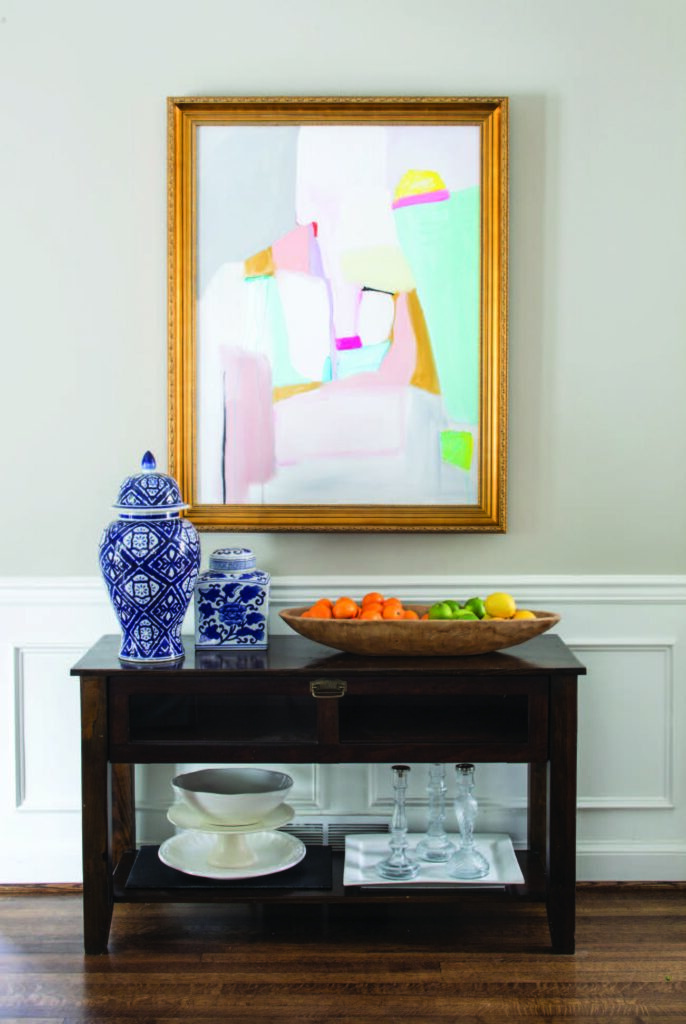Art: This time, it’s personal
Commissioning artwork for your new house is a fantastic way to personalize your space and establish the style of your home.
With the purchase of a new house comes a whole lot of wall space to fill. Rather than shoehorning your existing artwork into new spaces where it might not be the perfect fit, consider commissioning a piece that is uniquely designed for your new home, taking into account lighting, the dimensions of the room, the color palette in the space, and your own unique taste.
Commissioning artwork might sound daunting, but it’s actually a fairly straightforward process that allows you to express yourself, and to decorate your home in a way that maximizes your enjoyment of it. We spoke with three commissioning artists to understand the nuts and bolts of commissioning your own artwork.
Why commission when you can just buy?
If you need to fill a blank wall, it might seem easier to just search artworks until you find one that fits the space well enough. But a little extra effort will result in something that’s the perfect complement to your home and its inhabitants.
Artist Lanie Mann, who is based in Washington, D.C., says, “It’s extremely special to have a piece of art where you’ve worked directly with the artist—and an original piece that reflects you as the homeowner. You have a part in the creative process; this is something you can’t just go out and buy from a shop or gallery.”
Brooklyn-based geometric abstractionist Kane Grose points out that personalizing your artwork will ensure that it fits with your color and style preferences, saying, “You can customize artwork to fit your interior design palette, which is not easy to do when you’re searching through paintings on the internet. With a commission, you can customize a work so it’s 100 per cent personal to you.” From an artist’s point of view, Grose says that working on commissions is rewarding in terms of the end result. “It’s great doing commissions, because it allows you to really imbue an artwork with your client’s personality,” he says.
Choosing an artist
If you google “artist commission,” you will be presented with hundreds of thousands of search results, and many of them won’t deliver what you’re looking for. “Unless you know stylistically what you’re looking for, there’s a lot of searching involved,” Grose says. “The best place to look is online; Instagram is good—a lot of artists show their work there, so you can see their back catalogs just by scrolling. If you’re looking in person, a great idea is to find your local art precinct, and just go and visit the galleries there; often they will be showcasing the work of local artists.”
Once you’ve found an artist that you like, usually it’s not too difficult to get in touch with them to start the commissioning process. “Keep a list of artists’ work you are most drawn to,” Mann offers. “Most artists have a website, and there is usually a way to reach out to an artist directly to find out if they do commissioned work, and how they structure the commission process.”
Think about it
Before you start the commissioning process, make sure you have a good idea of the direction you want to take, the style of painting that you like, and exactly what you want from the artist. “Commissioning a piece of art is a special thing, so you want to make sure that you love the work of the artist you will be working with,” says Mann, and Grose agrees. “You are choosing an artist because of their particular style, so don’t go into the relationship expecting them to be able to do, or be comfortable doing, something that doesn’t fit with the work that they produce,” he says.
“Size and color are important to consider,” says Mann. “Think about what you love about the artist’s work, so you can communicate this with them, and it will be reflected in your commissioned piece.” Then there are the more practical things, like time and budget. If you need something quickly, or if you can only pay a certain amount, these factors might affect whether or not you can work with a particular artist. “Consider that, because it’s a commission, it’s more of a custom piece, and it will take a little longer to get delivered versus buying what’s available in the artist’s gallery,” New York painter Jen Ramos points out, continuing, “you should also consider your budget, because that will determine how much art you can afford.”
The artist needs to know
As with any custom project, the more information the artist has, the better your commissioned work will turn out. All three artists agreed that the most important question they will ask you relates to their existing work: which particular paintings are you drawn to from their collection, and why? Aside from that, Mann has an information gathering approach. “I ask about colors—usually they have a palette in mind—and for any inspiration photos. I am also happy to receive photos or swatches to help inform the palette. I don’t necessarily hope to completely match a color scheme—I think it’s best when the art can complement the space without being too ‘matchy’.” Ramos wants to know about the space, as well as who lives in the home. “I’ll ask them for photos of their space where the painting is going to hang, whether they have any children or if they’re married, what colors they like, what colors they don’t like, and how large they want the artwork to be,” she says. Grose says, “For me, it would be what the purpose of the piece is—if it’s a statement piece, or if it’s something that’s going in a low traffic area. Do they want it to be the center of attention, or to bring out other features in the room?”
If an artist is local, they might visit your home to get a better understanding of the space. “I’ve often visited local clients’ homes to take a look at the space where they want to hang the piece,” says Mann. “I can advise on what size might look best, and often recommend or tape out for them (using painter’s tape) the size of the canvas so we can visualize it in the space.” “If they’re local and they want me to visit, I’ll definitely do that,” says Grose. “If possible, it’s always good to see a space first—but at the very least, a few pictures with different angles of the space are really helpful.”

Don’t get rejected
Keep in mind that, even if you want to work with a particular artist, sometimes they will turn down the commission. This usually only happens if you are requesting something that doesn’t fit with their ethos or aesthetic. “It really depends on what it is that the client wants,” says Ramos. “I’ve had people contact me to do something that was very different to what I do, and I have declined it.”
To ensure that you don’t get too far down the commissioning path and then get disappointed, do your research, and engage in proper communication with the artist. Mann says, “If I feel that the request is too far from what I do as an artist, I will be up-front about it. I encourage having a phone call to discuss the process; I feel like an actual conversation helps connect us a bit better, and the connection is an important piece of a commission. I’ve worked with so many incredible people, and I love the connections that I’ve made.” The ins and outs Commissioning an artwork is a collaborative effort, so both parties will need to agree on what’s expected.
After initial discussions, the artist will provide you with a document that describes the expected piece, including time frames, budget and inclusions. You will usually be asked for a deposit, and both parties will sign the agreement. In terms of timing, it will depend on the size, the process, the amount of work involved and whether you would like the work framed, but you can expect anywhere from two weeks to a couple of months before your artwork is ready.
Expect to pay slightly more than you would for an off-the-shelf painting; usually an artist will charge a premium for the customized work. But pricing will depend on who you choose to work with, the size of the piece, the amount of work involved, and how advanced the artist is in their career. On average, the artists that we spoke to sell commissioned works in the range of $1,000–$5,000. It might be a little more effort, but an artwork that is a combination of your personality and the work of an artist that you admire can be the difference between a house and a home.
ABOUT THE ARTISTS
Lanie Mann is based in Washington, D.C., and creates “loose and layered” works, bursting with color and optimism. Her work encompasses figures, portraits and abstract composition.
Kane Grose is a Brooklyn-based geometric abstractionist, creating striking works with clean lines, vibrant colors and a splash of optical illusion. He calls his work pure abstraction, which he says “removes reality and allows the senses their free rein.”
Jen Ramos is a New York–based artist specializing in abstract works that mix bold and muted colors to great effect. Her work is underscored by feelings of happiness, joy, hope and sometimes a little chaos.


